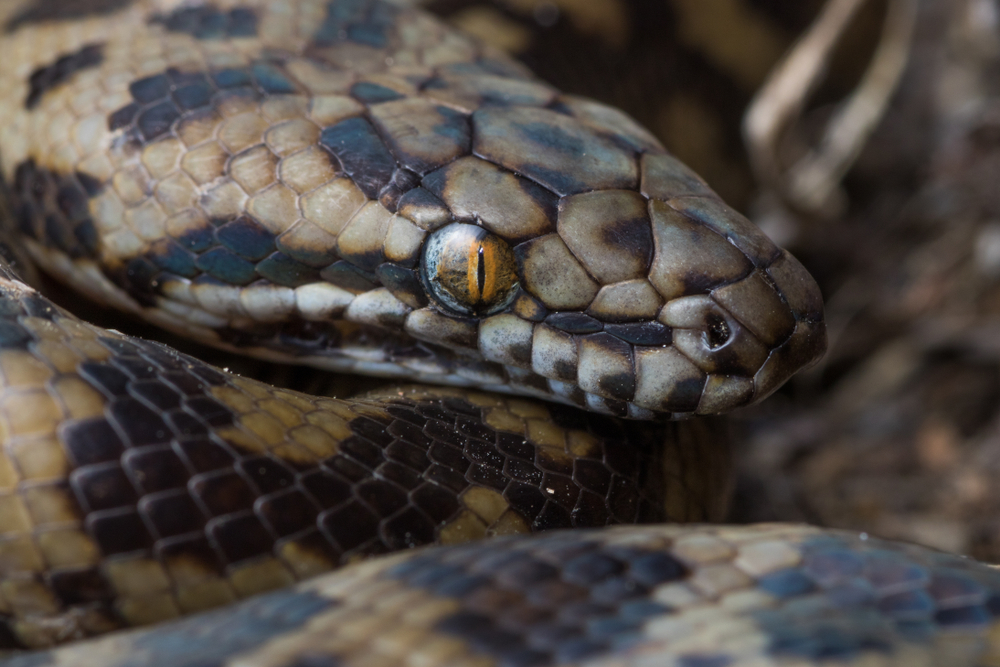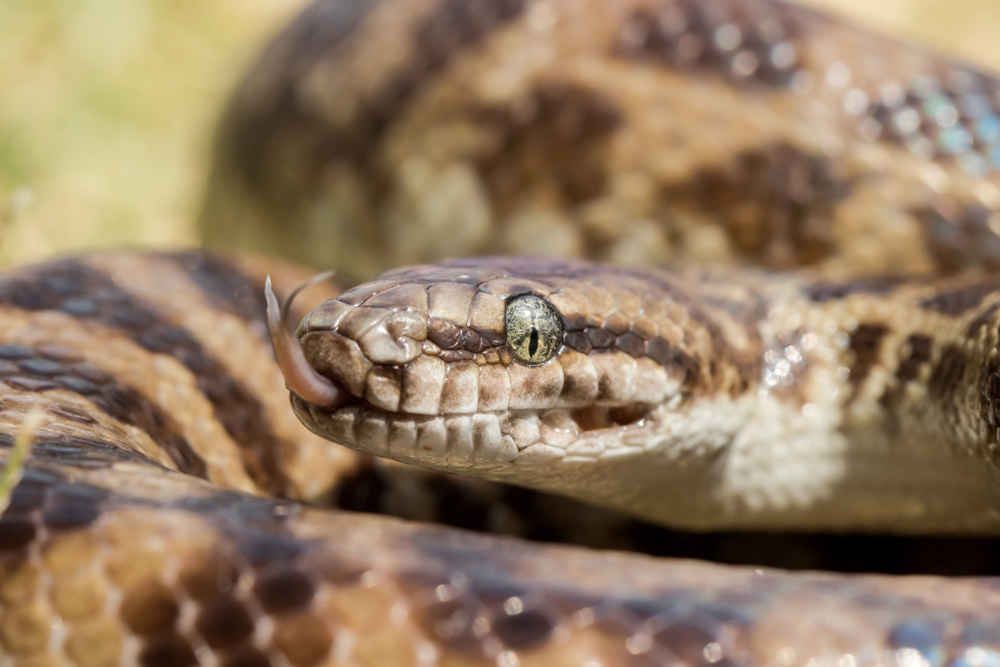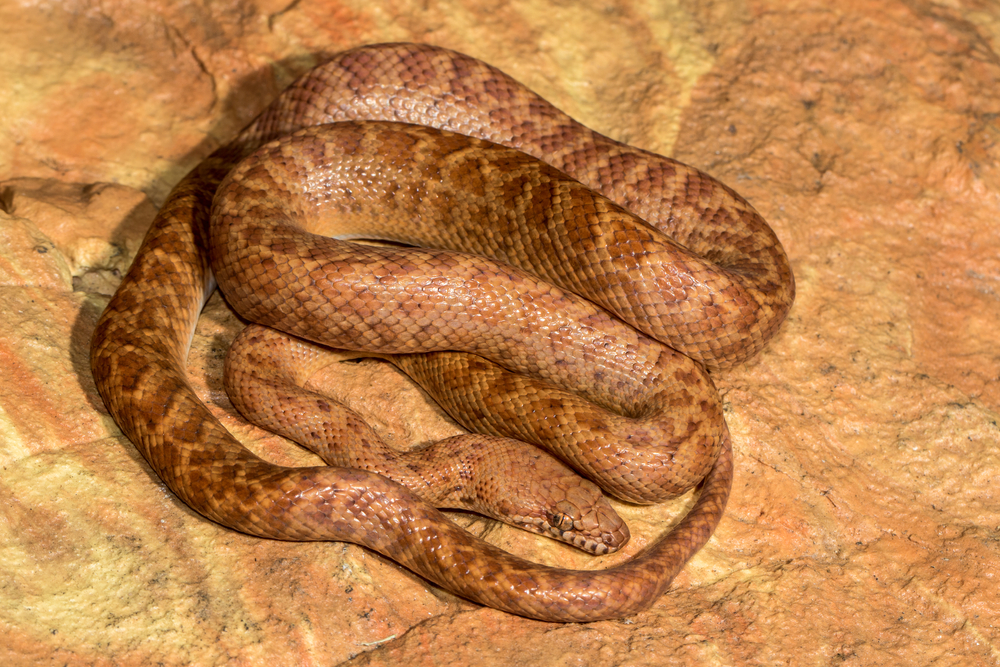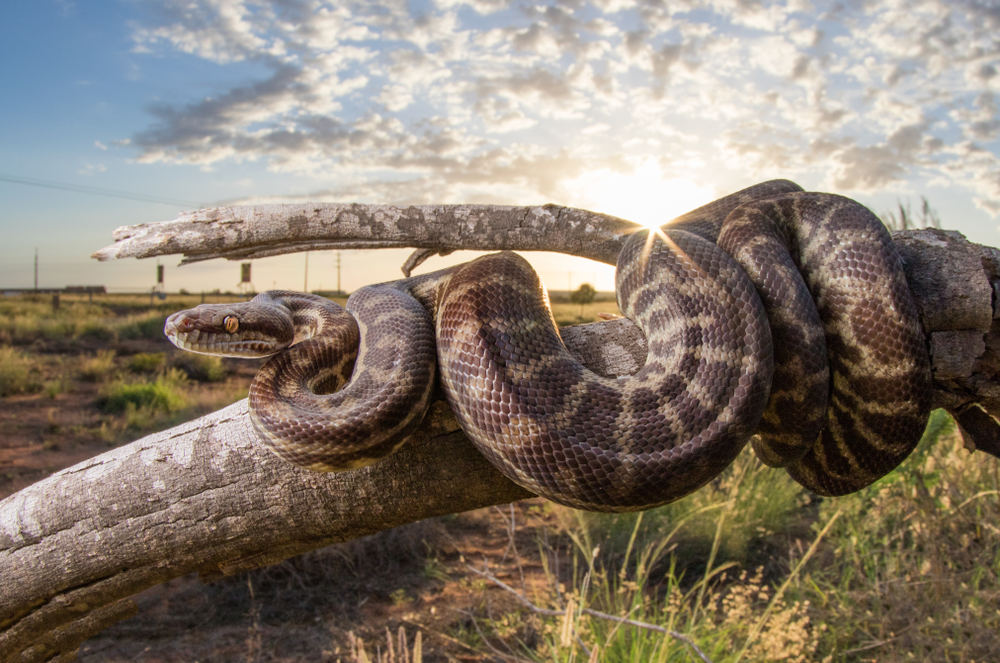Are these the best pet pythons?
The pygmy pythons of the genus Anteresia are perhaps the best pet pythons. Consisting of ‘chilidrens’ (A. childreni), ‘spotted’ (A. maculosa) and pygmy pythons (A. perthensis), this surprisingly diverse group of miniature constrictors are well-natured, inquisitive and can be housed comfortably in an off-the-shelf-sized vivarium. With an emerging morph hobby (particularly in their home country of Australia), Anteresia will surely increase in popularity in the coming years.
Spotted Python (Antaresia maculosa)
The spotted python occurs in northeastern Australia, from the Cape York Peninsula to New South Wales. It is, therefore, one of the more tropical species and inhabits a range of habitats from savannah to forest and experiences high humidity year-round. It is commonly associated with termite mounds, which offer refuge from seasonal extremes. The spotted python is the largest member of the Antaresia genus, growing to around four feet in length.
There are two subspecies of the spotted python. Both are found on the Australian mainland. These are somewhat contentious (as with most taxonomical revisions of this group of snakes). A. m. maculosa is the nominate form with the largest distribution, while A. m. peninsularis is found in far north Queensland. Some have also proposed calling A. m. maculosa the “southern spotted python” due to its geographical range, but this has yet to be readily used in the reptile-keeping hobby.
The spotted python is thought to be the oldest member of the genus. It diverged from other pythons around 23 million years ago. The pygmy and children’s pythons diverged from the spotted python later.
Being larger and more robust than other Antaresia and inhabiting a more tropical environment, spotted pythons make an excellent terrestrial alternative to carpet pythons. Similar environmental parameters in a well-planted 5 x 3 x 3 vivarium make for a great home. Spotted pythons prefer their enclosure slightly cooler than other Antaresia species. A hot spot of 35 °c combined with UV lighting and a strong temperature gradient is ideal.
Spotted pythons are also far more likely to be well-natured and tolerant to handling than carpet pythons. Whilst individual temperaments will vary greatly, even the largest Antaresia have a timid disposition.
Several ‘mac’ morphs are being produced in Australia. These include ‘striped macs’, which have loose lateral patterns and a distinct dorsal stripe that runs the length of the body. T- albino and axanthic animals have also entered the hobby, leading to a spectrum of combinations. A ‘granite’ line is also frequently bred outside of Australia and has been available to hobbyists in Europe and the US for many years. Spotted pythons are the most popular Antaresia species in captivity, followed closely by the children’s python. However, as ‘children’s’ and ‘stimsons’ pythons are now grouped, ‘children’s’ pythons probably outnumber spotted pythons in most countries.

Papuan Spotted Python (Antaresia papuaensis)
In 2021, Essquerre et al described a new species of Antaresia, the ‘Papuan spotted python’. Herpetologists had believed that there was some distinction between the spotted pythons in Australia and the spotted pythons in New Guinea for around two decades. Scale counts and genetic studies revealed this to be the case.
The Papuan spotted python occurs on several islands off the north coast of Queensland, as well as in Papua New Guinea. Because all Australian species are protected and thus cannot be exported from Australia, unnecessary pressures may have been placed on this species from the pet trade. A rise in demand for Antaresia in the 90s may have led collectors to move the Papuan animals over the border into Indonesia for easier export. Thus, today’s captive population of A. maculosa could also contain some remnants of A. papuanensis.
Children’s Python (Antaresia childreni)
The children’s python is named in honour of the 19th-century naturalist (and Curator of the British Museum at the time), John George Children. Whilst they are docile animals and many children do play with them (either historically in Aboriginal cultures or the modern-day reptile keeping hobby), they are not named for their suitability as a pet.
A 2020 study found that the Stimson’s python, the most widespread of all Australian pythons, is synonymous with the children’s python. Essentially, the ‘stimson’s python’ does not currently exist. This highlights the importance of locality data for the animals we keep, as this species is now known to inhabit some of the driest deserts of Australia’s interior, right through to cool coastal forests in southern Western Australia and tropical savannahs in Arnhem Land. Children’s pythons are some of the hardiest reptiles on Earth, and whilst each population will be independently adapted to their immediate environment, the species can tolerate an immense range of conditions.
Their vast range also leads to an immense variability. Children’s pythons vary greatly in size depending on their locality. Broadly, they are the least contrasted of the three larger Antaresia species. They are generally a dull brown in colouration with faint outlines of saddles down the dorsum. However, some individuals previously known as ‘Stimsons pythons’, particularly in the Wheatbelt area of Western Australia, are known for their beautiful contrasting patterns. In the Pilbara Region, children’s pythons also exhibit more defined patterns. Where they occupy shaded spinifex and rocky outcrops in harsh sunny conditions, a bolder pattern likely breaks their outline up better than a universal dull colouration.
Like the spotted python, children’s pythons have been bred in captivity for many years, and several morph variants have entered the hobby. They are extremely hardy and breed annually, with clutches of 10 – 15 eggs. Even these clutches hatch relatively quickly after just 45 days.
One should aim to gauge whether their python was labelled “A. childreni” or “A. stimsoni” prior to 2021. This will help guide husbandry practices. Traditional ‘children’s pythons’ occur in more tropical environments, north of the Tropic of Capricorn. These animals will see huge amounts of rainfall for several months. If a species is listed as a ‘stimson’s python’, it will have a more southernly distribution, and whilst seasonal rains in the Pilbara may lead to spikes in heat and humidity, the rocky outcrops remain reasonably barren, and the rains are much shorter. Populations previously described as “stimsons pythons” may also be found as far south as the Wheatbelt, which is much cooler and drier year-round than the historic range of the “children’s python.” For those listed as ‘Antaresia childreni, ‘ a more universal keeping method should be employed.
The largest children’s pythons can reach a significant size comparable to that of a king snake or large corn snake. A 4ft x 2ft x 4ft wooden terrarium is most suitable to allow some climbing space. Almost all terrestrial animals will happily climb a 4-foot surface, and therefore, utilising the extra space to build ledges allows the keeper to provide a spacious enclosure without acquiring a custom setup. Gradients are also slightly easier to achieve, as a basking ledge that hosts a hot spot of 38℃ will have a reduced impact on the ‘cool end’, which should be kept within the low 20s. Young children’s pythons can be snappy as they adjust to their new keepers. After settling in, they make wonderful pets.

Anthill Python (Antaresia perthensis)
The smallest of all boas and pythons, Antaresia perthensis is one of the most remarkable snakes on Earth. Known as the ‘anthill’ or ‘pygmy’ python, A. perthensis is found in rocky areas of the Pilbara, usually in sloping outcrops. Despite being named ‘perthensis’, it is not found near Perth. The type specimen was labelled ‘Perth’ and probably found its way to the closest city in the area accidentally, before being collected by Stull in 1923 for description.
Although recent studies have identified morphologically and genetically distinct populations, the anthill python has remained its species since it was described and is possibly the least controversial species in the Antaresia genus. It is, visibly, miniature. Whilst all pythons in the genus are small, the anthill python grows to just 50cm in length.
Anthill pythons, like many reptiles, probably do utilise termite mounds for shelter. However, their habitat does not require them, nor do they spend significant amounts of time in them. In some regions, population numbers can be surprisingly high. It’s possible to find several individuals in a single night whilst driving through suitable habitat.
Anthill pythons have the smallest distribution of all Antaresia species. They occur throughout the Pilbara region, including the hottest town in Australia, Marble Bar. During summer, it frequently exceeds 45℃ for several days or weeks. This is usually concurrent with heavy storms. In winter, temperatures drop to around 32℃. Anthill pythons are (unsurprisingly) nocturnal. They venture from their refugia when temperatures reach a more amicable temperature (usually in the low to mid 20s). Young snakes will feed mostly on small geckos and other nocturnal lizards, while adults may prey on small mammals.
Despite being locally abundant, anthill pythons remain some of Australia’s least-studied pythons. Most of their range is inaccessible, and therefore, their rise in popularity in captivity is leading to interesting revelations about their breeding behaviour. For example, there seems to be a correlation between herpetologists’ finding male and female specimens in close proximity in the field and terrarium observations of males actively pursuing females for long periods. Also, where male combat has been observed in A. childreni, it has not in A. perthensis. Breeders both in and outside of Australia have successfully bred the species and report “unusually large eggs”, usually of less than 5 per clutch. Whilst they are still rare in the hobby, they are not unobtainable. Their growth in popularity offers an excellent opportunity for a new generation of keepers wishing to maintain small species with interesting natural histories.
A 4 x 2 x 2-foot vivarium would comfortably house an anthill python for its life. In a naturalistic setup, full spectrum lighting and a spot bulb creating a 38℃ basking spot is appropriate. Clay-based substrate with layered slate and tile beneath the basking spot should allow the snake to cryptically bask (exposing part of their body to the heat whilst remaining mostly hidden). Ambient temperatures should be kept very high (+30℃), so that night temperatures do not fall too drastically. The Pilbara often sees rainstorms that spike humidity up to 80%; these rainstorms should be mimicked during the summer months and on the hottest days. Some keepers may, therefore, prefer a glass terrarium. However, with a typical humidity of 40 – 50% throughout the year, a wooden terrarium should be able to hold the occasional sharp spikes without warping or becoming too damaged.

Antaresia in the Hobby
“Children’s”, “Pygmy” or “Antaresia” pythons may be taxonomically confusing, but there are few snakes in the world that are as hardy, as interesting and as easy-to-house as this genus. Reptile keepers are more connected than ever. With better access to better equipment and social media guiding new keepers to great success in building naturalistic terraria, smaller species are becoming more popular.
Micro geckos, dwarf monitor lizards, thumbnail frogs and tiny turtles are some of the most sought-after species today. It is perhaps no surprise that keeping a snake with the same heat-seeking pits, immense constricting power and strikingly perceptive vertical pupils as a reticulated python (just scaled down) is appealing. If a growing morph breeding community helps to put more suitable species in the hands of more keepers, recent interest in Antaresia could spell a bright future for snake keepers all over the world… Let’s just hope the taxonomists agree!
